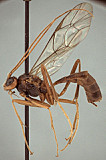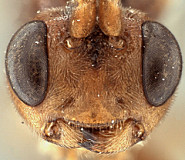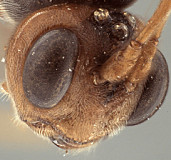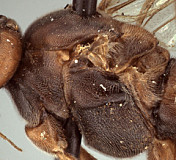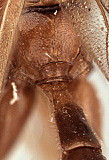Clypeus with ventral margin thick and bluntly rounded, without small lateral tooth or projection; ventral margin convex; epistomal sulcus indistinct, barely indicated by slight change in angle of clypeus in profile. Malar space distinct, roughly half basal width of mandible. Mandible short, broad, evenly convex, ventral and dorsal tooth of equal length, dorsal tooth slightly broader. Ocelli small, lateral ocellus shorter than distance between ocellus and eye. Maxillary palp moderately long, about equal to head height; female antennae longer than body; first flagellomere with no apparent tyloid. Hypostomal carina joining occipital carina well above base of mandible; occipital carina complete. Dorsal end of epicnemial carina a little removed from anterior margin of mesopleuron, terminating dorsally in rounded transverse ridge that sharply delimits a median longitudinal furrow extending across the middle of the mesopleuron. Notaulus absent. Distinct u-shaped groove present between propodeum and metanotum in lateral view; pleural carina complete, well-developed; propodeum with complete posterior transverse carina, lateral longitudinal carina present posteriorly, carinae large effaced medially anteriorad posterior transverse carina, with weak, irregular, longitudinal striae along midline, areola absent. Apical margin of mid tibia with distinct tooth similar to that on fore tibia; comb on hind tibia present, but details not clearly visible on the single specimen available for study; posterior hind tibial spur at least 7x longer than maximum width at base; tarsal claws completely pectinate. Fore wing areolet present; Rs+2r arising slightly basad middle of stigma. Hind wing with first abscissa of CU1 distinctly shorter than 1cu-a. T1 long, slender, without dorsal carinae; without median, basal depression at dorsal tendon attachment; dorsal-lateral carina nearly absent between spiracle and apex of T1, weakly developed posteriorly; glymmae on each side meeting on the midline posterior to dorsal tendon attachment, large, deep, separated at midline by translucent partition. T2 thyridium present; laterotergites of T2 and T3 completely separated by creases. Ovipositor straight, with subapical notch; ovipositor sheath straight, relatively narrow, bluntly rounded apically. Male not examined, but
Townes (1970) stated that the tip of the aedeagus was bent over and ended in an adze-like blade.
This genus is represented by Metopheltes petiolaris Uchida, 1932 (Japan); and Opheltes chinensis Morley, 1913 (China).

